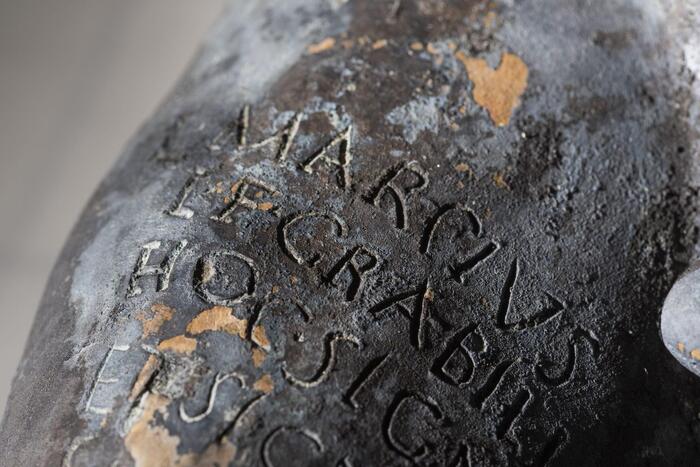Internal human organs reproduced in bronze with great precision, as perhaps only those who have truly "seen" can do
.
In addition to the surgical instruments offered to the divinities together with the dozens and dozens of votive offerings, which often have the shape of human limbs and organs - legs and arms but also wombs and penises - tell of obtained or at least desired healings.
In the large thermal sanctuary of San Casciano, which was first Etruscan and then Roman, medicine was most likely actually practiced, complete
with surgical interventions under divine protection
who could count on a tradition of more in-depth medical knowledge than what was believed up to now.
A few months after the most sensational discoveries from the Tuscan archaeological site, the first results of the impressive campaign of studies on the finds returned from the boiling waters of this corner of Tuscany seem to confirm the hypotheses put forward by the team of archaeologists who discovered it.
"Absolutely preliminary data",
the archaeologist Jacopo Tabolli, who coordinates the research, told ANSA.
Reflections and studies that for the first time, and in record time compared to the closure of the last excavation campaign just two months ago, are compared between specialists of the various disciplines who have been involved to study every single aspect of the find, from geophysical nature of the water to the coins, from the construction technique used to forge the bronze statues to the Etruscan and Latin inscriptions that have been engraved on them.
And then the system of ex votos, gifts to the gods in the form of wood and fruit.
The occasion
is a two-day conference ("Inside the sacred") which opens today in Siena with 54 speakers from all universities and specialized institutes of Italy in the presence of the minister of culture Gennaro Sangiuliano and the rector Tomaso Montanari in the Virginia Woolf great hall of the University for Foreigners,
where Tabolli - who since 2019, flanked by the director
Emanuele Mariotti and Ada Salvi
guide the adventure of these excavations - teach etruscology.
"An appointment that is particularly important for us - underlines Montanari - also because it tells us of a past of coexistence between diversity and because our students, young people who come from different countries of the world, took part in the excavation. In short, a mission and a study , in which our vocation is perfectly fulfilled".
Culture Minister January Sangiuliano is enthusiastic.
"The ministry of culture will pay maximum attention" he assures speaking at the conference, "We have agreed to have a first exhibition of the bronzes in Rome, at the Scuderie del Quirinale", then all the finds will find a place in the museum of San Casciano, he underlines, announcing that the ministry I bought
the building dedicated to the story of the site in the historic center of the Tuscan town.
After the media clamor of the discovery, a meeting that demonstrates "how research never stops" points out in turn
the general director of archeology of the MiC Luigi La Rocca.
While
Massimo Osanna, head of the state museums,
announces that the works for setting up the museum have already started: "The feasibility study is already ready".
The novelties that have emerged from this first phase of studies, Tabolli anticipates, are already many.
Starting with the name of the divinity that most of all identified this place, "Flere Havens", which in Etruscan can be translated as "The god of the Fountain":
the etruscologist Adriano Maggiani
found it in the dedications carved on five of the bronze statues deposited around the 1st century AD in the oldest part of the basin.
In short, the numen, at least in the first phase of the sanctuary's life and before the arrival of the Roman goddess Fortuna, is precisely the same source, which is "divinized" due to the enormous healing power attributed to these waters
.
Not only that: examining the bronzes that emerged it was understood that the weight of the statues was also important.
From the smallest to the largest, these finds are all "multiples" of precise weight systems.
As if to say that the amount of metal donated also counted in the offer.
Which would explain why in the last phase of use, the Roman one, coins were offered directly.
And again, the two 'polyviscerals', i.e. the two ex votos with the representation of the internal organs so precise as to resemble a modern CAT scan, seem to refer to 'anatomical models' in use in the sanctuary
.
A medicine that operated on advanced scientific bases, therefore.
And that at the same time ranged in the field of divination, as seems to underline the bronze thunderbolt placed above the statues when the Etruscan basin was sealed by the Romans who had taken turns at the helm of the sanctuary.
The topics are many.
With a common thread which is that of inclusiveness: different cultures, rites, even languages that meet and coexist here without wars and without tears.
Centuries pass and the ancient world changes.
Yet in the bubbling pools of San Casciano it is always the hot water that commands, the healing force to which everyone bows down.
Wars and conflicts stay out here.

